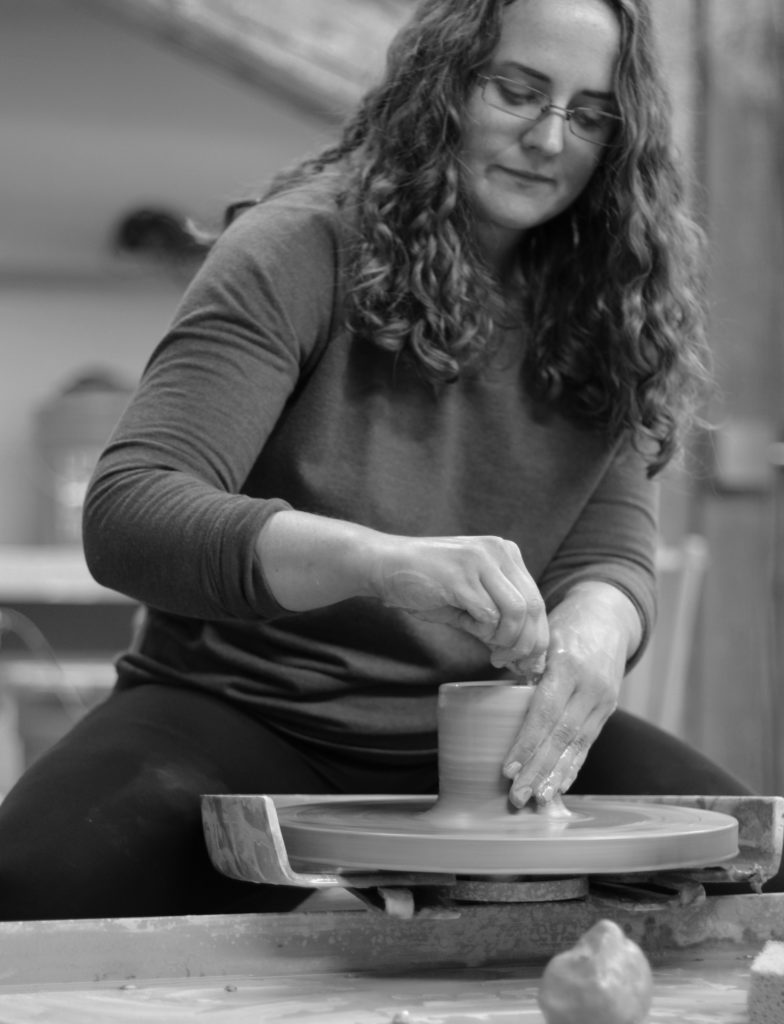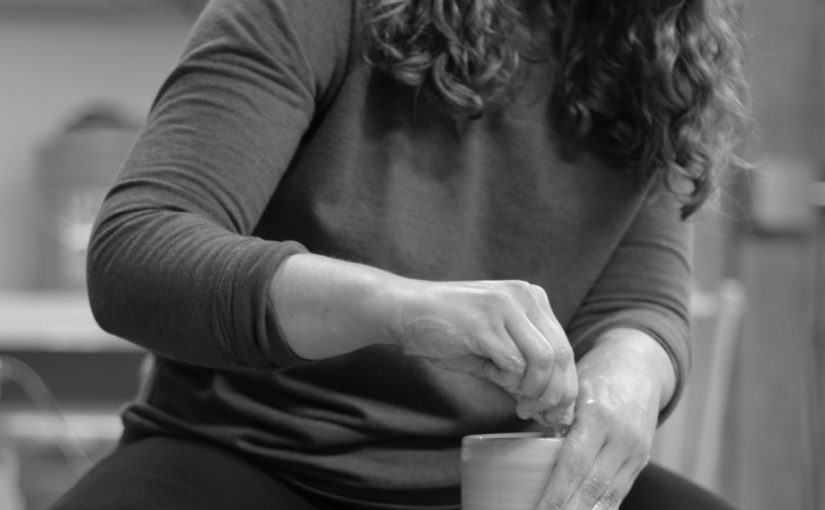
Even though she’s not a full-time ceramics artist, Polkinghorn dedicates plenty of time to learning
more about ceramics and everything that comes with it (including firing kilns and mixing glazes
and clay).
Ashley Polkinghorn is throwing clay on a wheel in the Renaissance Hall ceramics studio. I’m sitting across from her, trying my best to handle the sopping wet ball of mud she gave me to work on.
This is my first time working with clay.
Polkinghorn glances up from her work and smiles. This, by far, is not her first time at the wheel. This has been her everyday world for the past three years.
It shows in how easy it is for her to manipulate the clay on the wheel in front of her. She makes the experience look easy.
However, it wasn’t always this way.
“I started taking classes at the community studio at the Plains Art Museum,” Polkinghorn said. “I just signed up for a class. I had room in my life for a new thing, and it sounded awfully interesting. I took a class and I never left.”
This was Polkinghorn’s first taste of ceramics.
When she first took the class, Polkinghorn said she “laughed out loud” when she first touched the clay.
“When it spins, it’s just the weirdest thing,” she said. “It’s stretchy dirt, basically.”
“The first thing I loved about clay was how it felt,” she said.
Polkinghorn makes everything from mugs and bowls to teapots and decorative vases. Of course, now she makes it look easy. But Polkinghorn assures me her first pot collapsed.
Of course, she said, this delighted her.
From there, she was hooked. Polkinghorn delved into the world of ceramics, taking more classes at the Plains and starting her own pottery business on Etsy.
Eventually, ceramics became more and more important to her, and the hours she could spend at the Plains Art Museum studio became more and more scarce. She also wanted to experiment with multiple ceramics processes, like mixing glazes, mixing clays and firing kilns.
Then, she happened upon the Renaissance Hall studio space.
“I knew a resident artist who was here last year,” she explained. “She really liked the facility. I just kind of showed up here. I talked to the department head, and I talked to a couple of the professors. They were like, well, do you want to do a residency or do you want to take Ceramics IV? And I was like, residency sounds pretty good.”
The facilities at Renaissance Hall provided Polkinghorn with all the tools she needed to excel in ceramics, including areas where she could experiment with glazes and clays and, her favorite, the soda kiln.
Unlike a wood-fired or electric kiln, the soda kiln uses baking soda. The baking soda vaporizes in the kiln and creates a glaze on the ceramic pieces.
“It’s a wild card because you never know exactly what’s going to happen,” Polkinghorn said. “The soda can make a glossy kind of glaze. Where it’s in shadow, it can get orange flashing and be more matte. It’s awesome.”
The kiln is by far where Polkinghorn wants to spend more time experimenting. Already, she’s working on using different techniques within or involving the kiln to add an extra something to her pieces.
This includes a slow-cool technique. Usually, electric kilns cool faster than their wood-fired or gas counterparts. However, with a slow cool, the glaze forms differently on the clay pieces.
“You can get really shiny surfaces if you go fast,” she said. “I think even with some of the glazes I’ve been using now, I can get some more matte, maybe crystalized surfaces if I slow it down.”
Polkinghorn is at the very beginning of her ceramics career and is excited to learn much more about not just ceramics, but also about other art forms.
After taking classes at the Plains, Polkinghorn’s art has grown immensely. Starting without being able to make a pot, now Polkinghorn loves to make pieces as tall as 3 feet. She’s even beginning to delve into the world of 2D art. She’s already taken painting and printmaking classes.
“I’ve been able, more lately, to be exposed to different media,” she said. “Which is what I wanted. I just wanted an exposure. I’d only really worked in clay, and I was like, I wonder what all these other things are doing.”
Yet her love for clay and ceramics keeps her rooted.
Her work is like something out of nature: fluid and graceful, with earthy glazes. Looking at her existing work, viewers get the sense that they’re looking at floral and leafy shapes.
“I’m kind of trying to make a sense of grace and motion in my pots right now,” she explained. “I get inspiration from the way the clay reacts to me as well. And, of course, I have some vaguely botanical motifs.”
She draws inspiration from tulips and crocuses, but continues to look for inspiration in the natural world around her.
When she thinks of an idea, she usually sketches it out before throwing the clay. This, she makes clear, is to take down an idea as she thinks of it rather than having a blueprint for how the final piece will turn out.
“It’s my first evolution of the pot,” she said.
As she throws the clay and builds up the piece, Polkinghorn’s pot will evolve with the movements of the clay or the volume of the piece. By the end, the piece is merely the ghost of the original idea, built up into something entirely new.
“I think it’s kind of too bad that we lose so much of (the creative process) in the final product,” she said. “When I go to art shows, I see the object that someone made, but I can’t see how they got there or all the other things it could have become.”
She continued, “There’s a gazillion tiny decisions you make as you’re making a work. There are so many different ways it could have gone. Maybe you’ll do another iteration where it’s slightly different, but you can never do them all.”
Especially in the Renaissance Hall space, Polkinghorn is finding her process is changing like her space has changed.
“Being in such a new place with new people around too, I’ve been making forms I’ve never made before,” she said.
Polkinghorn said she hopes to be an artist in residence in the Renaissance Hall studio space for at least a year, working on her pieces, learning new techniques and continuing to grow as an artist.
“This is just the tip of the iceberg,” she said, gesturing to the studio space around her. “I know so much more than I knew three years ago, but I still know nothing.”
To see more of Ashley Polkinghorn’s pieces, follow her on Instagram @AshleyPolkinghorn, Facebook @PolkinghornCeramics or on her Etsy page @PolkinghornCeramics.
She will also be at the Red River Market on Oct. 6, and her work is currently on display as part of the “Cone Pack Invitational: A Place at the Table” exhibit at the Plains Art Museum.
